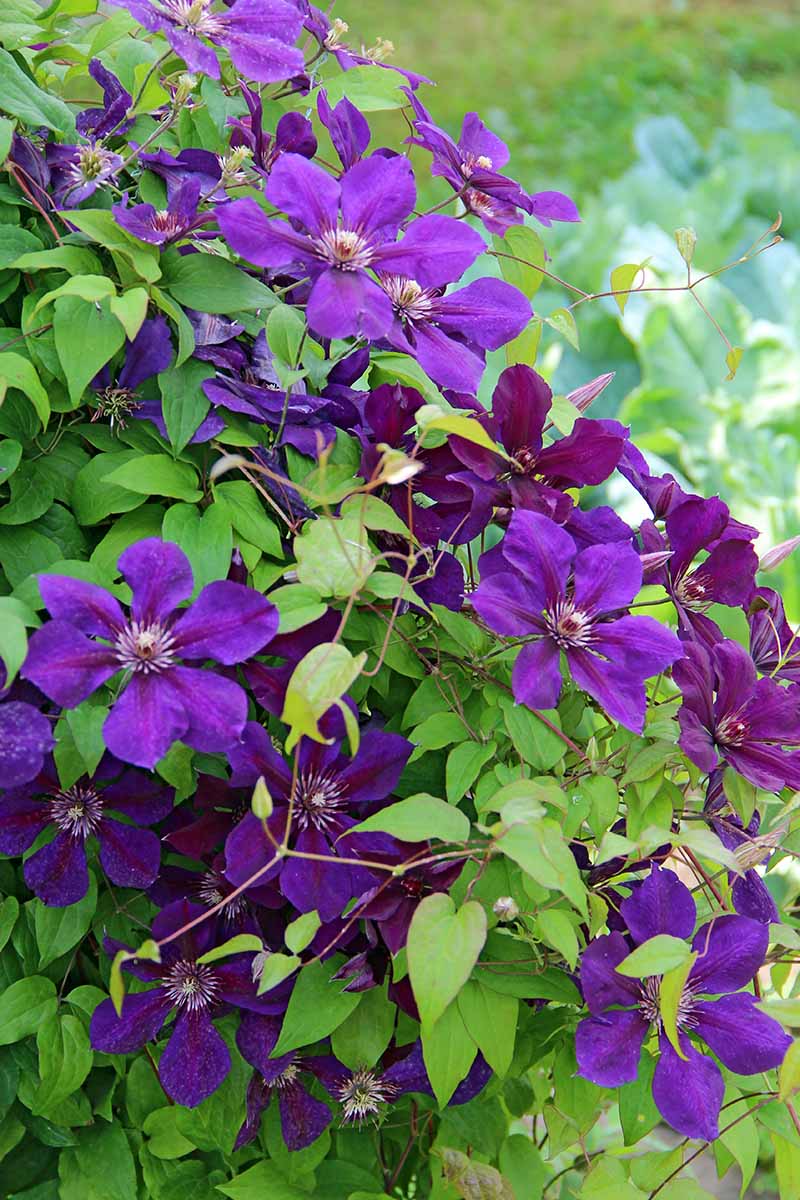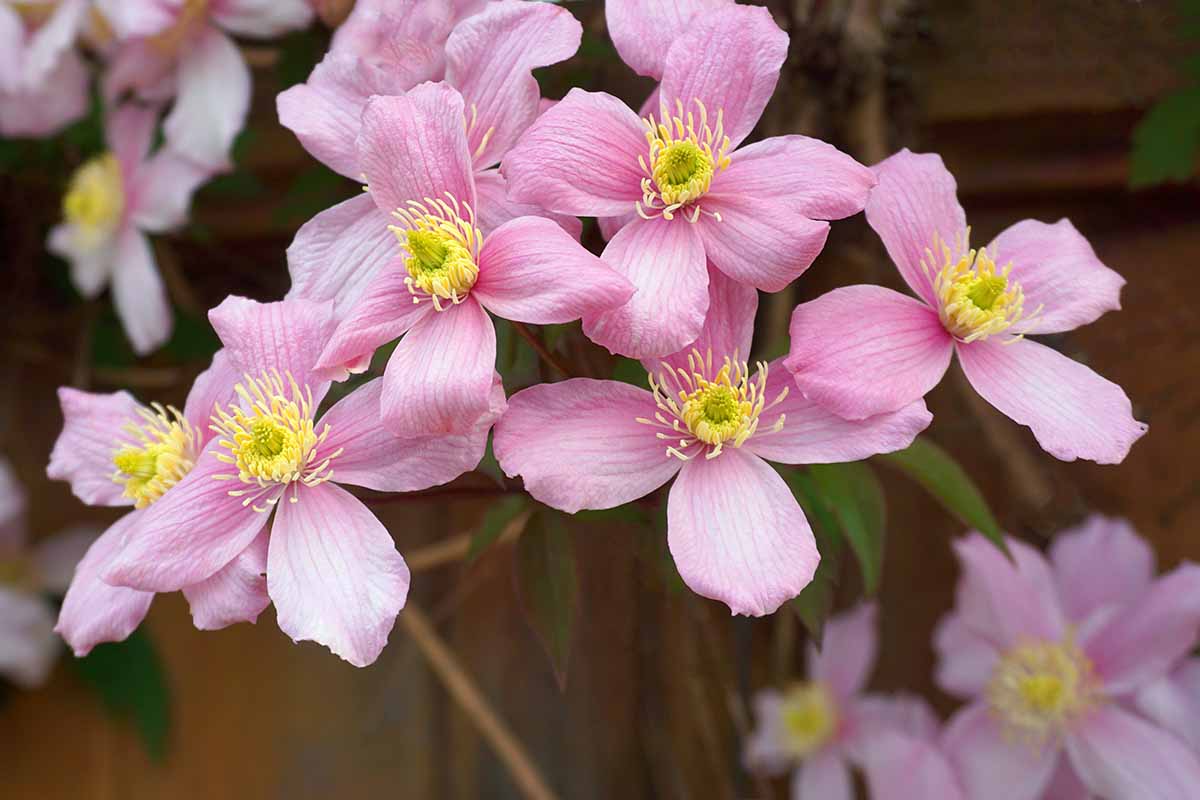Clematis plants have been on a bit of a rollercoaster when it comes to their reputation. And these vines don’t love being transplanted.
In the Victorian era, they were associated with cleverness because they could twine themselves up any old surface with relative ease.
Later, they were seen as fickle, disease-ridden, and difficult to raise. Or, on the other end of the spectrum, invasive enough to warrant extreme control measures.
Today, they’re popular all over again because there are so many marvelous improved hybrids and cultivars.

We link to vendors to help you find relevant products. If you buy from one of our links, we may earn a commission.
But they can still be tricky to care for without the necessary knowhow.
The first few times I attempted to move one of these to a new location many years ago, my vines took ages to re-establish themselves.
I know better now, and hopefully, you can learn from my mistakes so you won’t find yourself having a conversation with your stunted vines, begging them to explain what you can do to help them along.
The reason for their reluctance to move is that these plants take a good long time to establish their roots.
That’s why your vine often won’t start showing off with abundant flowers for several years after planting. It puts all its energy underground first.
When you move them, they won’t flower as well as they once did for several years. That’s just the cost of transplanting.
But there’s no reason why they can’t be as big and beautiful as they ever were. Here are the steps you need to make the big move:
What You’ll Learn
If you have a vine that you really adore and you can’t move it, or you really don’t want to risk losing it, try propagating it via cuttings.
That way, if the vine dies after a move, or if it’s you that’s moved away, you still have a way to keep it.

When my grandma passed, I wanted to keep the clematis she had planted over a trellis that arched across the walkway entrance to her house.
I didn’t want to risk losing it when we moved it, so I took cuttings to be safe. Turns out, I didn’t need to, but it was nice having the peace of mind.
So, how can you move your plants the right way with minimum risk? Let’s talk transplanting:
When to Move Your Plant
Technically, you can move your clematis at any time of year. But if you want to reduce the chances of transplant shock, do it in the late winter or early spring before the buds start to emerge.
Second best is in the fall after the vine goes dormant, when the ground is still workable.
If you move the plant while it’s actively growing, cut it back by about half. This reduces the number of leaves and stems that the disturbed roots need to support.
Your clematis will likely be stunted for the rest of that season, but if you get enough of the roots, it should recover the following year.
Prep the Area
Before you even think about digging up your vine, you should prepare the new area first. This reduces the chance of transplant shock.
Dig as big of a hole as you can. Depending on how mature the plant is, the roots can be several feet deep and at least as wide as the dripline of the plant, but probably several inches wider.
So dig a hole that is at least as big as you estimate the roots you’re digging up will be.
If you want to go the extra mile, dig a little bit deeper and wider, and work some well-rotted compost into the native soil.
You can never go wrong with a little compost since it adds water retention to sandy soil and improves drainage in clay. It also adds nutrients. What’s not to love?
Dig Up the Plant
Now it’s time to do the real work. Do this on a day when the temperatures are cool. An overcast day that’s a bit chilly and not too windy is just right.
As much as I want to keep my fellow gardeners comfortable, it’s really for the plant. Wind and sun dry the roots out rapidly.

Make sure you can plant it right away. Don’t start digging on a day when you might be interrupted, and the plant will sit around. Oh, how many times have I made that mistake? It never turns out well.
If you didn’t prune back your clematis in the fall, trim it back a bit now. If you aren’t sure how to prune your particular type of clematis, check out our guide for some tips.
Now, dig a hole all the way around the drip line, or even a few inches out from the drip line, around the entire circumference of the plant. Dig down at least two feet, assuming that your vine is more than a year old.
You can’t dig too large of a margin, so err on the side of too deep and wide rather than the other way around. If you encounter roots larger than a pencil in diameter as you’re digging, you need to move several inches out and try again.
Once you’ve done the initial digging, shove that shovel under the roots and gently tilt the shovel back to lift and wedge the roots out of the soil. You might need to remove the shovel and re-insert it in a few different areas to really get it out.
Try not to be too aggressive. If you hear a bunch of roots ripping and popping, stop pulling and dig a bit wider and deeper, then try again. I know it’s annoying, but the more of the root structure you get, the happier your plant will be.
Eventually, the whole thing will pop out of the ground. Place it in a wheelbarrow or wagon or on a tarp and move it to the new location. Save your back for this next step.
Replanting
Before you transplant, take a look at the roots. You don’t need to knock away all the dirt and do a thorough check. But just give them a once over and see if they look okay.
If you see mushy or black roots, it means your plant probably has a little root rot going on. Remove as many of these roots as you can, and then dig the new hole even deeper to ensure good drainage, backfilling it with a mix of compost and native soil.
Put the plant in the ground and situate it so that it sits slightly lower than it did in its previous location. Fill in around the roots with soil. Water well and let the soil settle.
You’ll probably need to add a bit more soil to top it off. Add some mulch on top to protect the roots. Leaf or hardwood mulch works best.
Care
Throughout the following year, you don’t need to provide any extra care, but be extremely diligent to stick to the recommended care routine.
If you aren’t familiar with that, our guide to growing clematis has you covered.
Your vine won’t perform with its usual glory in the year or two following its big move. Don’t worry, it just needs some time. You didn’t do anything wrong.
Remember, clematis wants to establish a healthy root system before it goes about flowering abundantly.
Move Your Clematis to the Perfect Home
There’s no reason for you to have to deal with a plant that’s growing in the wrong location. Or, if your friend has a vine they want to get rid of, you can always give it a new home.

Clematis has a reputation for being a challenge to transplant, but don’t let that hold you back. It will return to its former glory in a snap, so long as you follow the steps outlined above.
Why are you moving your vine? Aiming for a better location? Taking one with you when you move? Let us know all about your situation in the comments.
Did this guide help you figure out how to move your plant? I hope so. Want to learn even more about clematis vines? Great! We have several guides that might catch your eye:
I’m new to gardening and bought a clematis whose label said it could be grown in a pot but it’s July and not doing very well. I’ve tried a lot to help it but think it needs to be moved to the ground so I’ll try transplanting it. It’s cool and overcast today so I think today’s the day! Thanks for this article, I hope it will adjust well and thrive in its new location.
Good luck! Let us know how it goes!
I have a clematis planted by my previous house owners hidden behind a massive rhododendron so it gets not much light and no sun. I don’t think I’ve even ever seen it flower. I was thinking of moving it to a long planter pot at the top of my drive so it can grow up a trellis against a wall but reading the above would this be far too shallow for its roots? I’d love to move it but don’t have many possible alternative locations.
Hi Jill, how large is the container? A clematis does best in a pot that is at least two feet deep and wide. If you can give it something about that size, it should be fine.
Thanks Kristine, haven’t bought a container yet but will make sure it’s 2 feet wide and deep. Is it ok to move it now? It’s the beginning of autumn here in Scotland.
Yep, feel free to move it now (so long as you aren’t experiencing some crazy heatwave!). Clematis does best if you move it later in the fall when the vine goes dormant, but it should be fine so long as you take up plenty of root and it isn’t too hot.
Hi! I have a Ville De Lyon I want take with me in a move I have coming up. I believe I remember reading, somewhere, that Clematis don’t like TOO much sun & it was, therefore, recommended that they be planted on the N, NE or NW side of a structure to shield it stress of full Southern exposure. In refreshing myself about how I can best replant my VDL, I haven’t found any mention about this on any site I’ve visited, though. I don’t know, now, whether my recollection on this is correct or if I might have it… Read more »
Hi there. Clematis actually like full sun, though some will also thrive in partial shade. Aim for an area with six hours or more of sun per day. The plants don’t like hot roots, though, which is why some people stick them in shadier areas. Ideally, you’d give your Ville de Lyon at least six hours of sun but protect the base of the plant with something to shade it. I’ve been experimenting with strawberry plants at the base of my clematis and its working great. A lot of people opt to put large rocks or a thick layer of… Read more »
I have a beautiful 24 yr old jackmani clematis growing by my privacy fence. The fence is being replaced and could take 8 weeks. I am so nervous to dig it up but have to. Do I transplant it temporarily or try to keep it in a pot? I don’t have anywhere to move it permanently. Thanks
Hi Rebecca, it’s early enough in the season (assuming you’re in the northern hemisphere) that it should be fine. Try to get up as much of the roots as you can. Whether you keep it in a pot or the ground is up to you. A pot might be easier for you when it comes time to replant. Just don’t let the roots get hot in the container. Maybe prop some evergreen boughs against the container to protect it from sun exposure. Good luck!
Hello, I’ve just bought a Fair Lady clematis in a small pot, thinking I could just see how to repot it on the internet and I’d be set, but now realize it may not like being moved in this July summer heat. I do not garden, but wanted this beautiful plant on my full sun balcony. So I have a 2 foot pot to put it in, but do I have to wait for fall to replant it? It currently has 2 flowers blooming, and about 3 more budding. Help please! 🙂 Thankyou
Hi there, you are right, clematis doesn’t like being transplanted in the heat. But in this case, it might be best to go ahead and move it into its new pot because the sooner you cool the roots down, the better. Right now in the presumably black growing container, they’re probably overheated. I’d wait for an overcast day or take the plant inside and transplant it into the pot. It’s probably best if you pinch off the flowers so the plant can concentrate on its roots rather than flowering. Give it a day or two and then bring it back… Read more »